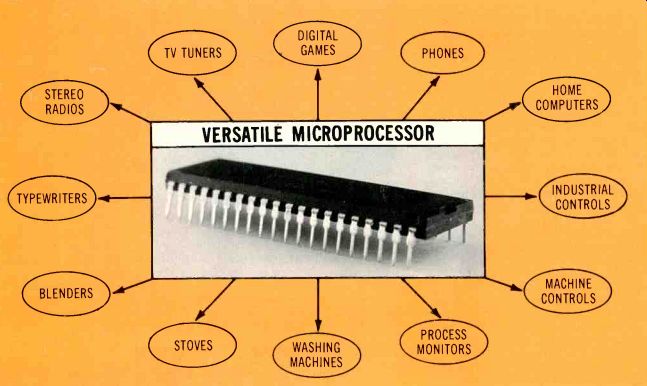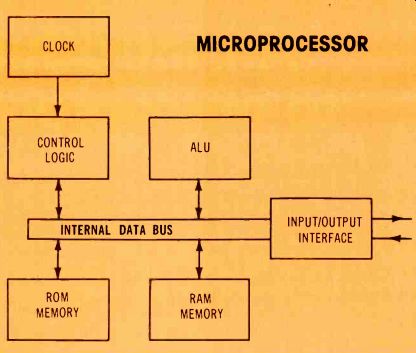By Carl Babcoke, Editor
This brief overview of microprocessors is presented as an introduction to the new series that begins this month in Electronic Servicing. These articles will bridge the gap between the theory of these complex circuits and practical field servicing.
Microprocessors defined Microprocessors have been a major factor in the digital electronics revolution. And yet they remain something of a mystery.
Defining a microprocessor is complicated by a lack of standardization caused by rapid growth.
Microprocessors are linked to computers, yet they can perform many complex programs alone. There is no clear distinction between micro processors and microcomputers or minicomputers.
According to one simple definition, a microprocessor is a single integrated circuit (IC) which can perform about 75% of the operations usually done by a small computer. What's more, most small modern computers include a micro processor to do the mathematics and control functions.
In broadest terms, microprocessors are programmable devices which control sequential processes and whole machines by the manipulation of digital signals.

Basic functions
Late -model microprocessors contain (usually inside one IC) these four basic sections:
an arithmetic -logic unit (ALU) which sometimes is called a processor;
control logic with a timing clock;
two kinds of memory; and
input-output devices (which by multiplexing can be the same unit with two functions).
Together the ALU and the control-logic circuits often are referred to as a Central Processing Unit (CPU). A CPU is comparable to a digital calculator, since it takes care of the mathematical functions, among others. Also, the CPU acts as a speedy delivery service, taking data between memories (they can not communicate directly with each other) and obeying commands from the Read Only Memory (ROM) or (through an encoder) from an operator.
A CPU has two kinds of inputs and outputs that operate on the signal busses. Address lines always are outputs, while data lines can handle either input or output data, depending on the timing.
On command, the CPU assigns data to certain sections of Random-Access Memory (RAM) and ROM memories. Then it checks to be certain the data corresponds to those particular address locations.
RAMs are the temporary store houses for data that will be needed later, including the program that controls the microprocessor.
ROMs are brains that are manufactured with permanently stored information. When asked, each ROM tells the CPU what it should do, how to accomplish the action, when to do it, and where to place the data afterwards.
Notice that the CPU never operates alone. It is a good servant that works rapidly and accurately at whatever it's instructed to do.
That's why most new-type microprocessors have some ROM, RAM and input-output capability pro vided inside the same IC package.
Additional memories of both kinds can be added externally and connected into the signal busses where the CPU can carry their data too.

Classic 8080
One of the first popular micro processors is the 8080 which has been manufactured by many companies. Large-Scale Integration (LSI) technique was used to pack a complete microprocessor into one 40 -pin DIP case. IC 8080 has 16 address lines, 8 data lines, 10 control lines, 4 power pins and 2 pins for clock input. It is an 8 -bit microprocessor that can address up to 65,536 8 -bit words. Therefore, it is said to have a 64K memory.
In this microprocessor, a bit is a binary 0 or 1, while a byte is 8 contiguous bits found in a single memory location. A word is 16 contiguous bits that occupy two successive memory locations.
These specifications indicate that the 8080 has a fair amount of computer capabilities, in addition to a large potential for controlling many complex operations. While newer microprocessors have even more capabilities, they lack the wealth of software that's available for the 8080.
Typical uses A complete list of all the jobs a microprocessor can perform would fill many magazines. However, they can be lumped into three basic categories:
programmable controllers;
arithmetic units; and
sequencers.
Not all applications use the full capabilities of microprocessors, which are available in 4-bit, 8-bit and 16-bit versions. For example, microprocessors used in home appliances, business machines, video tape editors or audiotape recorders probably are selected mostly for the control functions.
Microprocessor is the most popular term for a new feature of many new products in a multitude of fields. A few microprocessor-controlled TV tuners are in production now, and every TV line is expected to have a version by next year.
Every technician should learn enough about microprocessors to permit analyzing and servicing any systems that contain them. This recommendation is for all kinds of electronics, because microprocessors now are (or soon will be) found in all branches.
The new series about micro processor circuit operations (which begins elsewhere in this issue) will help fill the gap between engineers complex information and practical field servicing of the equipment.
-----------
Also see: Intro to Microprocessors